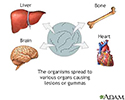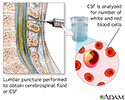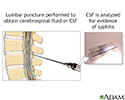Syphilitic aseptic meningitis
Meningitis - syphilitic; Neurosyphilis - syphilitic meningitisSyphilitic aseptic meningitis, or syphilitic meningitis, is a complication of untreated syphilis. It involves inflammation of the tissues covering the brain and spinal cord caused by this bacterial infection. These tissues are called the meninges.
Meningitis
Meningitis is an infection of the membranes covering the brain and spinal cord. This covering is called the meninges.

Syphilis
Syphilis is a bacterial infection that is most often spread through sexual contact.

Causes
Syphilitic meningitis is a form of neurosyphilis. This condition is a life-threatening complication of syphilis infection. Syphilis is a sexually transmitted infection.
Neurosyphilis
Neurosyphilis is a bacterial infection of the brain or spinal cord. It usually occurs in people who have had untreated syphilis for many years....

Syphilitic meningitis is similar to meningitis caused by other germs (organisms), but it doesn't develop as quickly.
Risks for syphilitic meningitis include a past infection with syphilis or other sexually transmitted illnesses such as gonorrhea. Syphilis infections are mainly spread through sex with an infected person. Sometimes, they may be passed by nonsexual contact.
Gonorrhea
Gonorrhea is a common sexually transmitted infection (STI).
Symptoms
Symptoms of syphilitic meningitis may include:
-
Changes in vision, such as blurred vision, decreased vision
Changes in vision
There are many types of eye problems and vision disturbances, such as: Halos Blurred vision (the loss of sharpness of vision and the inability to see...
 ImageRead Article Now Book Mark Article
ImageRead Article Now Book Mark Article - Fever
- Headache
- Mental status changes, including confusion, decreased attention span, and irritability
Confusion,
Confusion is the inability to think as clearly or quickly as you normally do. You may feel disoriented and have difficulty paying attention, remembe...
 ImageRead Article Now Book Mark Article
ImageRead Article Now Book Mark Article - Nausea and vomiting
- Stiff neck or shoulders, muscle aches
-
Seizures
Seizures
A seizure is the physical changes in behavior that occurs during an episode of specific types of abnormal electrical activity in the brain. The term ...
 ImageRead Article Now Book Mark Article
ImageRead Article Now Book Mark Article - Sensitivity to light (photophobia) and loud noises
-
Sleepiness, lethargy, hard to wake up
Lethargy
Fatigue is a feeling of weariness, tiredness, or lack of energy.
 ImageRead Article Now Book Mark Article
ImageRead Article Now Book Mark Article
Exams and Tests
Your health care provider will perform a physical exam. This may show problems with the nerves, including nerves that regulate eye movement.
Tests may include:
-
Cerebral angiography to check blood flow in the brain
Cerebral angiography
Cerebral angiography is a procedure that uses a special dye (contrast material) and x-rays to see how blood flows through the brain.
 ImageRead Article Now Book Mark Article
ImageRead Article Now Book Mark Article -
Electroencephalogram (EEG) to measure electrical activity in the brain
Electroencephalogram
An electroencephalogram (EEG) is a test to measure the electrical activity of the brain.
 ImageRead Article Now Book Mark Article
ImageRead Article Now Book Mark Article -
Head CT scan
Head CT scan
A head computed tomography (CT) scan uses many x-rays to create pictures of the head, including the skull, brain, eye sockets, and sinuses.
 ImageRead Article Now Book Mark Article
ImageRead Article Now Book Mark Article -
Spinal tap to obtain a sample of cerebrospinal fluid (CSF) for examination
Spinal tap
Cerebrospinal fluid (CSF) collection is a test to look at the fluid that surrounds the brain and spinal cord. CSF acts as a cushion, protecting the b...
 ImageRead Article Now Book Mark Article
ImageRead Article Now Book Mark Article - Serum VDRL or serum RPR (used as a screening test for syphilis infection)
If screening tests indicate a syphilis infection, more tests are done to confirm the diagnosis.
Treatment
The goals of treatment are to cure the infection and stop symptoms from getting worse. Treating the infection helps prevent new nerve damage and may reduce symptoms. Treatment does not reverse existing damage.
Medicines likely to be given include:
- Penicillin or other antibiotics (such as tetracycline or erythromycin) for a long time to make sure the infection goes away. It is typically given initially using the intravenous route.
Intravenous
Intravenous means "within a vein. " Most often it refers to giving medicines or fluids through a needle or tube inserted into a vein. This allows th...
Read Article Now Book Mark Article - Medicines for seizures.
Outlook (Prognosis)
Some people may need help eating, dressing, and caring for themselves. Confusion and other mental changes may either improve or continue long-term after antibiotic treatment.
Late-stage syphilis can cause nerve or heart damage. This can lead to disability and death.
Possible Complications
Complications may include:
- Inability to care for self
- Inability to communicate or interact
- Seizures that may result in injury
-
Stroke
Stroke
A stroke occurs when blood flow to a part of the brain stops. A stroke is sometimes called a "brain attack. " If blood flow is cut off for longer th...
 ImageRead Article Now Book Mark Article
ImageRead Article Now Book Mark Article
When to Contact a Medical Professional
Go to the emergency room or call 911 or the local emergency number if you have seizures.
Contact your provider if you have a severe headache with fever or other symptoms, especially if you have a history of syphilis infection.
Prevention
Proper treatment and follow-up of syphilis infections will reduce the risk of developing this type of meningitis.
If you are sexually active, practice safer sex and always use condoms.
All pregnant women should be screened for syphilis. Also, people at increased risk for getting syphilis should be screened for it. Common examples include men who have sex with men, people with HIV infection, young adults, and people with a history of incarceration, sex work, military service or illicit drug use.
References
Dionne JA, Ghanem KG. Syphilis. In: Goldman L, Cooney KA, eds. Goldman-Cecil Medicine. 27th ed. Philadelphia, PA: Elsevier; 2024:chap 295.
Hasbun R, van de Beek D, Brouwer MC, Tunkel AR. Acute meningitis. In: Bennett JE, Dolin R, Blaser MJ, eds. Mandell, Douglas, and Bennett's Principles and Practice of Infectious Diseases. 9th ed. Philadelphia, PA: Elsevier; 2020:chap 87.
Radolf JD, Tramont EC, Salazar JC. Syphilis (Treponema pallidum). In: Bennett JE, Dolin R, Blaser MJ, eds. Mandell, Douglas, and Bennett's Principles and Practice of Infectious Diseases. 9th ed. Philadelphia, PA: Elsevier; 2020:chap 237.
US Preventive Services Task Force website. Syphilis infection in nonpregnant adolescents and adults: Screening. www.uspreventiveservicestaskforce.org/uspstf/announcements/final-recommendation-statement-screening-syphilis-infection-nonpregnant-adolescents-and-adults. Updated September 27, 2022. Accessed November 9, 2024.
-
Meninges of the brain - illustration
The organs of the central nervous system (brain and spinal cord) are covered by connective tissue layers collectively called the meninges. Consisting of the pia mater (closest to the CNS structures), the arachnoid and the dura mater (farthest from the CNS), the meninges also support blood vessels and contain cerebrospinal fluid. These are the structures involved in meningitis, an inflammation of the meninges, which, if severe, may become encephalitis, an inflammation of the brain.
Meninges of the brain
illustration
-
Meninges of the spine - illustration
The organs of the central nervous system (brain and spinal cord) are covered by 3 connective tissue layers collectively called the meninges. Consisting of the pia mater (closest to the CNS structures), the arachnoid and the dura mater (farthest from the CNS), the meninges also support blood vessels and contain cerebrospinal fluid. These are the structures involved in meningitis, an inflammation of the meninges, which, if severe, may become encephalitis, an inflammation of the brain.
Meninges of the spine
illustration
-
Central nervous system and peripheral nervous system - illustration
The central nervous system comprises the brain and spinal cord. The peripheral nervous system includes nerves outside the brain and spinal cord.
Central nervous system and peripheral nervous system
illustration
-
Primary syphilis - illustration
Syphilis is a sexually transmitted disease caused by the bacterium Treponema pallidum. Primary syphilis presents as a small painless open sore 3 to 6 weeks after exposure. Although the lesion heals within 6 to 8 weeks, the untreated organism will continue to multiply unchecked, causing many complications. Infection may last for 30 years or more and result in severe neurological complications.
Primary syphilis
illustration
-
Syphilis - secondary on the palms - illustration
Secondary syphilis is one of the few infectious diseases that produces rashes on the palms and soles, as well as a generalized rash. If an ulcer on the penis is followed several weeks later by a rash, the person should always be evaluated for syphilis.
Syphilis - secondary on the palms
illustration
-
Late-stage syphilis - illustration
Tertiary syphilis is a late stage of the disease which can follow the initial infection, primary syphilis, by several years. Pockets of damage accumulate in various tissues such as the bones, skin, nervous tissue, heart, and arteries. These lesions are called gummas and are very destructive.
Late-stage syphilis
illustration
-
CSF cell count - illustration
CSF (cerebrospinal fluid) is a clear fluid that circulates in the space surrounding the spinal cord and brain. A CSF cell count is a test to measure the number of red and white blood cells that are in CSF.
CSF cell count
illustration
-
CSF test for syphilis - illustration
Venereal disease research laboratory test (VDRL) of the cerebrospinal fluid (CSF) is used to screen for syphilis. CSF is a clear fluid that circulates in the space surrounding the spinal cord.
CSF test for syphilis
illustration
-
Meninges of the brain - illustration
The organs of the central nervous system (brain and spinal cord) are covered by connective tissue layers collectively called the meninges. Consisting of the pia mater (closest to the CNS structures), the arachnoid and the dura mater (farthest from the CNS), the meninges also support blood vessels and contain cerebrospinal fluid. These are the structures involved in meningitis, an inflammation of the meninges, which, if severe, may become encephalitis, an inflammation of the brain.
Meninges of the brain
illustration
-
Meninges of the spine - illustration
The organs of the central nervous system (brain and spinal cord) are covered by 3 connective tissue layers collectively called the meninges. Consisting of the pia mater (closest to the CNS structures), the arachnoid and the dura mater (farthest from the CNS), the meninges also support blood vessels and contain cerebrospinal fluid. These are the structures involved in meningitis, an inflammation of the meninges, which, if severe, may become encephalitis, an inflammation of the brain.
Meninges of the spine
illustration
-
Central nervous system and peripheral nervous system - illustration
The central nervous system comprises the brain and spinal cord. The peripheral nervous system includes nerves outside the brain and spinal cord.
Central nervous system and peripheral nervous system
illustration
-
Primary syphilis - illustration
Syphilis is a sexually transmitted disease caused by the bacterium Treponema pallidum. Primary syphilis presents as a small painless open sore 3 to 6 weeks after exposure. Although the lesion heals within 6 to 8 weeks, the untreated organism will continue to multiply unchecked, causing many complications. Infection may last for 30 years or more and result in severe neurological complications.
Primary syphilis
illustration
-
Syphilis - secondary on the palms - illustration
Secondary syphilis is one of the few infectious diseases that produces rashes on the palms and soles, as well as a generalized rash. If an ulcer on the penis is followed several weeks later by a rash, the person should always be evaluated for syphilis.
Syphilis - secondary on the palms
illustration
-
Late-stage syphilis - illustration
Tertiary syphilis is a late stage of the disease which can follow the initial infection, primary syphilis, by several years. Pockets of damage accumulate in various tissues such as the bones, skin, nervous tissue, heart, and arteries. These lesions are called gummas and are very destructive.
Late-stage syphilis
illustration
-
CSF cell count - illustration
CSF (cerebrospinal fluid) is a clear fluid that circulates in the space surrounding the spinal cord and brain. A CSF cell count is a test to measure the number of red and white blood cells that are in CSF.
CSF cell count
illustration
-
CSF test for syphilis - illustration
Venereal disease research laboratory test (VDRL) of the cerebrospinal fluid (CSF) is used to screen for syphilis. CSF is a clear fluid that circulates in the space surrounding the spinal cord.
CSF test for syphilis
illustration
Review Date: 8/29/2024
Reviewed By: Jatin M. Vyas, MD, PhD, Roy and Diana Vagelos Professor in Medicine, Columbia University Vagelos College of Physicians and Surgeons, Division of Infectious Diseases, Department of Medicine, New York, NY. Also reviewed by David C. Dugdale, MD, Medical Director, Brenda Conaway, Editorial Director, and the A.D.A.M. Editorial team.










